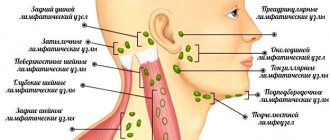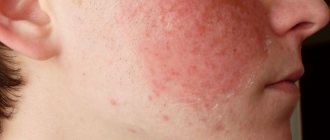Papilloma is a neoplasm that appears on the skin, mucous membranes and is warty in nature. Pedicled papilloma is a benign formation, but it brings discomfort and may be accompanied by unpleasant sensations.
Papillomas equally often affect men and women, and there is an opinion that the process of their active formation occurs during the aging of the body. What is pedunculated papilloma? What provokes its appearance? Are there differences in stages and types? What effective methods can medicine offer?
Papillomas on the arms, legs, neck, torso and mucous membranes of a person are a consequence of infection of the body with the human papillomavirus. This disease occurs independently; its stages of development will completely depend on the characteristics of the body and the person’s lifestyle.
What happens if you tear off a papilloma on a leg?
When a pedunculated papilloma is detached from the base, the benign neoplasm begins to become inflamed.
This creates a wound surface.
All this is accompanied by itching and increased body temperature.
There is suppuration and swelling due to the inflammatory reaction.
Remains of papilloma must be removed in a hospital setting.
Such injuries threaten the degeneration of a benign papilloma into a malignant neoplasm.
Sometimes, with good immunity, papillomas come off and new ones do not grow.
There is no negative impact.
The recovery is complete.
Pedicled papilloma: diagnosis, histology
Pedicled papillomas, like other papillomas, must be subjected to histological examination.
This will complement the cytological examination.
The histological examination method consists of analyzing a biopsy specimen - a part of the papilloma obtained during its removal.
A microscope is used for this.
We evaluate the nature of the benign tumor and determine the degree of oncogenicity of the papilloma.
Within three days after the study, we have the result.
The diagnosis of papillomatosis when infected with HPV occurs on the basis of laboratory diagnostics:
- cytological analysis (to determine changes in the cellular material of the test sample);
- carrying out a polymerase chain reaction (to find viral DNA in the material under study);
- obtaining a biopsy specimen for histological examination;
- carrying out the histological examination itself;
- conducting a daijin test.
The Daijin test is carried out to determine the type of HPV, its quantity and degree of oncogenicity.
Without laboratory research methods, based only on the clinical picture, even an experienced doctor has difficulty in making a correct and accurate diagnosis.
Complications of papillomas
The most important complication is the degeneration of benign neoplasms into malignant tumors.
It is necessary to determine as quickly as possible the type of HPV that caused the formation of papillomas.
If it is a highly oncogenic type 16 or 18, constantly monitor the development and changes in the condition of papillomas.
These pedunculated papillomas also threaten traumatization and relapse.
You should always remember this and avoid injury, and after removing papillomas, prevent their occurrence.
Types of formations
There are several types of formations that differ in the following characteristics:
These are single papillomas, which in most cases affect the upper leg, foot, or they may appear on the toe. Papilloma in the upper leg in most cases indicates sexual infection.
They rise slightly above the place of formation. If such papillomas are not removed, they can degenerate into malignant formations.
Plantar
Such papillomas form on the toes or throughout the foot, causing pain and discomfort during movement.
Endodermal
They cause pain when they come into contact with shoes or clothing. Their difference is the brown tint. Since this type of papilloma can cause cancer, when they appear, treatment should be started immediately.
There are a number of ways to get rid of papillomas, which are determined by the doctor after examining the patient. It is very important to understand that the use of traditional medicine can have a short-term effect or have no therapeutic effect at all. Since these formations have a viral feature, plants cannot influence the destruction of the virus itself. It is most advisable to use drug therapy or minimally invasive methods.
Degeneration of papillomas into malignant pathology
We must always remember that HPV poses a risk of cancer.
Especially highly oncogenic types, for example, 16 and 18.
Typically, malignant degeneration of papillomas cells takes ten to twenty years from the moment of infection.
The process is accelerated by smoking, drinking alcohol, obesity and hormonal disorders that reduce immunity.
It is the decrease in immunity, which occurs for various reasons, that contributes to the activation of HPV and the transition of the benign state of papillomas to a malignant pathology.
The destruction of papillomas is enhanced by cytomegalovirus, genital herpes, chlamydia, syphilis, gonorrhea, and trichomoniasis.
And of course, you need to avoid frequent trauma to papillomas, which contributes to their malignancy.
A direct indication for removal of papillomas is the presence of large papillomas.
They are often hurt and hurt.
Methods for removing papillomas
There are quite a lot of methods for removing papillomas.
Let's consider everything.
Firstly, it is the destruction of papillomas using a special liquid containing alkali.
They are purchased in pharmacies with prescriptions from the attending physician.
The disadvantage is considered:
- the need for precise local application of liquid to papillomas,
- risk of chemical burns to adjacent tissues,
- painful procedure,
- the possibility of scars appearing at the site of papillomas removal.
Usually, the method is used to remove single vulgar papillomas (warts) of the hands.
It is not suitable for filamentous papillomas.
Refrigerants are used for cryodestruction.
Basically, liquid nitrogen is used.
Although other refrigerants are possible.
The application of the coolant is painless; acute pain occurs later when “defrosting” occurs.
After a certain time, the surrounding tissues turn red and swell.
There is an active formation of a subcutaneous bladder filled with fluid.
After a week (maximum one and a half months), everything heals and is restored.
It takes three weeks for the tissue under the crust to die, while the infected tissue is reliably destroyed.
There are no scars, and any traces disappear within six months.
The intimate area and face are not treated with this method.
Firstly, the genital area is very sensitive.
And secondly, it is not suitable for the face due to post-operative swelling and redness of the surrounding tissues.
Using a special device, papillomas are removed using radio wave coagulation.
Most often they use Surgitron.
The method does not cause pain.
Several radioknives in the kit allow you to choose the most convenient one for papilloma of a given location.
The radioknife provides directed high-frequency radiation, which cuts off the papilloma, “evaporating” its tissue.
There is no rehabilitation period.
The operation is quick, painless and leaves no traces of the intervention.
But if there are acute inflammatory processes or worsened chronic ones, then radio wave coagulation is not used.
Diabetes mellitus, pregnancy, lactation and any cancer pathology in the body are also contraindications for using the method.
But if there are no contraindications, the method can be successfully used anywhere.
Patients say that the only drawback of the method is the discomfort at the time of administration of the anesthetic.
Laser beams are also used to remove papillomas without contact.
Healthy tissues are not damaged.
Infected papilloma tissues seem to “evaporate” under the action of a laser beam.
A session of laser removal of papillomas does not take long, just a few minutes.
Complete rehabilitation takes place in two weeks.
Side effects include prolonged redness of the skin and swelling of adjacent tissues.
Problems with the thyroid gland contribute to the formation of keloid scars.
Contraindications for the use of laser coagulation are the presence of:
- diabetes mellitus;
- acute inflammatory processes;
- epilepsy;
- disorders of endocrine and immune status;
- photoderomatosis;
- thrombocytopenia.
Patients who have undergone laser coagulation report pain and an unpleasant “burnt meat” smell.
Long-term rehabilitation, pain and tendency to relapse with this method.
Small papillomas are removed by electrocoagulation or cauterization.
Rehabilitation takes place within a week.
Reliable and inexpensive method.
Any localization of papillomas is suitable for its use.
To remove large papillomas or malignant neoplasms, a scalpel is used.
Stories from our readers
Got rid of these terrible tumors at home. A month has already passed since I forgot about the bleeding and nasty growths in the most “prominent” places. Oh, I tried so many things - it helped, but only temporarily. How many times did I go to the clinic, but they prescribed useless medications over and over again, and when I returned, the doctors simply shrugged their shoulders. There were also folk remedies such as potatoes, which did not help. I also tried various celandines, which also turned out to be ineffective. I was already on the verge of a nervous breakdown and wanted to literally “cut” them, but then a miracle happened... Finally, there is not a single growth on my body and all thanks to this article. Anyone who has “unloved” growths should read this! You will forget about this problem forever, just as I forgot about it!
Read the full article >>>
For more information about leg papilloma, as well as a lot of other useful information, watch our video:
Causes of recurrence of papilloma after removal
The causes of recurrent papillomatosis are improper treatment.
Weak immune defense also contributes to the reappearance of papillomas.
Therefore, by all means you need to be treated correctly and in a timely manner by an experienced specialist and strengthen your immune defense.
And this approach will ensure a favorable course of HPV after surgery to remove papillomas.
To remove pedunculated papillomas, contact the author of this article, a dermatovenerologist in Moscow with many years of experience.
Source: kvd-moskva.ru
Causes of papilloma on the leg
Statistics say that about 70% of the population of the entire planet is infected with the papilloma virus. But not every person knows that they are a carrier of the disease. This is because the virus usually does not manifest itself and is asymptomatic. But for a number of reasons, it can be activated and lead to the formation of skin growths on the body. Papillomas begin to appear due to a severe weakening of the immune system. The following factors can cause this discomfort:
- A long-term illness that destabilizes the body’s protective function;
- Long-term abuse of alcoholic beverages or smoking;
- Experiencing severe stress.
If a person does not have serious health problems, the virus in his body can survive the incubation period for decades. However, according to doctors, papilloma on the stem still appears six months after infection with the virus.
You can become infected with the human papillomavirus under various circumstances. This usually occurs through contact with an HPV carrier. Most often, an intimate relationship with an infected person leads to this outcome. The infection is also transmitted through kissing and oral contact. It is not so difficult to catch the disease using the personal hygiene products of a virus carrier and his towel.
Another option for infection is the appearance of a wound on the body. If it is not treated in a timely manner, pathogenic microorganisms will quickly enter the blood and under the skin. It is enough to get slightly injured while shaving to get a whole scattering of papillomas.
One should not exclude the possibility of transmission of papilloma from a mother to her child during the passage of the baby through the woman’s birth canal.
Papillomas can be transmitted from mother to child
Causes
The main and only cause of all papillomas is the human papillomavirus, or HPV for short (more about this virus). Parasites in the intestines are not the cause of papillomas!!! (see disclosure from Elena Malysheva).
HPV under an electron microscope
Let me briefly remind you of the information about the HPV virus:
- This is a non-enveloped DNA virus that integrates into the chromosomes of squamous epithelial cells of the skin and mucous membranes
- Infection occurs through contact
- Damaged skin becomes infected (abrasions, scratches, cracks)
- Infection occurs already in childhood (types of virus that cause warts)
- The types of virus that cause genital warts are sexually transmitted
- The virus usually lies dormant in the human body and becomes active when immunity decreases.
- It is difficult to completely remove the HPV virus from the human body - you can only muffle it by strengthening the immune system
Appearance of papilloma on the stalk and the place of its formation
The beginning of the development of the pathological process is indicated by the appearance of a small nodule on the skin. It gradually grows and gradually separates. The neoplasm remains connected to the skin only by a small stalk. The growth itself takes on an elongated shape. Sometimes doctors diagnose patients with round papillomas of this type in the legs, arms or other parts of the body.
If you study photos of patients who have papilloma on a thin stalk, you can find out where it is most often localized. Such a neoplasm is usually located in the following areas:
- Neck;
- Eyelids and area around the eyes;
- The groin and the folds that are next to it;
- Armpits;
- The fold that forms under the breast.
Neoplasms of this type appear in these areas for a reason. Experts have found a pattern in this. In places where benign growths are localized, there is very thin skin. They affect areas of skin folds, as they are characterized by high humidity. And these are ideal conditions for the development and reproduction of pathogenic microflora that activates a viral disease.
Location
Acrochordon can occur separately or in clusters. The most common locations are the neck and armpits, also the face (eyelids) and neck, under the breasts in women, although any skin folds can be affected, including the groin and buttocks, even unusual areas of the body (endoscopy can reveal a papilloma arising in the ureter).
Histologically, it presents as a polypoid lesion with hyperacanthotic epidermis. A loose, edematous, vascular-fibrous core with mild chronic inflammation is observed.
Three types of education are described:
- Small wrinkled papules approximately 1-2 mm wide and high, located mainly on the neck and armpits.
- Single or multiple filamentous lesions approximately 2 mm wide and 5 mm long, occurring on different parts of the body.
- Large, pedunculated, sac-like, soft fibroids that occur in the lower torso.
Considerable attention has been paid to giant acrochondons in the axillary and genital organs, which cause significant discomfort in patients.
Genital acrochordon (in women) is more often observed in the vagina than in the vulva and cervix with a peak of the disease at the age of 20-40 years (very rarely during postmenopause).
Large lesions may arise from the proliferation of mesenchymal cells in the hormone-sensitive subepithelial stromal layer of the lower genital tract.
Rarely, vulvar acrochordons ranging in size from 2.5 to 30 cm with ulcerative formations, recurrent infections and inflammations are found. In every case of fibroepithelial stromal polyp, malignancy must be excluded.
Danger of papilloma on the leg
Pedicled papillomas should be considered benign neoplasms. This means that they are safe for humans. But you need to understand that such a growth can appear on absolutely any part of the body. It is easily injured when putting on or taking off clothes, during water procedures and other manipulations. It is quite easy to damage the papilloma and tear it off. But such situations should never be allowed, since a positive outcome of this event is unlikely.
If the papilloma that grows on a stalk is still torn off, there is no need to panic. The first step is to thoroughly treat the wound with a disinfectant. Then you should go to an appointment with a dermatologist. It is undesirable to delay a visit to a specialist for too long, as this can lead to unpleasant consequences that will affect the health of the HPV carrier.
Papilloma on the leg
Complications of pathology
In most cases, papilloma does not create any problems for a person. But not all neoplasms appear and develop asymptomatically. Some of them turn out to be a source of incessant itching and irritation. Often a burning sensation is felt in the affected area. But the biggest problem with this pathology is the appearance of pain in the area where the growth is located. If you have these symptoms, you should contact your doctor immediately. They are not normal and may indicate serious health problems.
Mostly, complications arise after the papilloma is accidentally torn off, thereby damaging its leg. In such situations, you need to go to the clinic. Doctors recommend saving the torn piece so that a specialist can examine it for goodness. To better preserve the sample, it is advisable to place it in saline solution.
Sometimes the papilloma turns black. This sign cannot be called good. You should also be wary if the skin around the tumor begins to turn red and itch. All these are signs of an inflammatory process. Because of it, the growth increases in size. If such changes are detected, it will not be possible to limit yourself to just visiting a dermatologist. In this case, you will need to consult an oncologist.
If the papilloma on the leg comes off
Papilloma, which is attached to the skin with just a thin stalk, is not so difficult to damage. If this does happen, a person should act as follows:
- Fill the wound with hydrogen peroxide. With its help, you can not only disinfect damaged tissues, but also stop bleeding;
- Apply any antiseptic composition to the damaged area;
- Cover the wound with a bactericidal plaster.
This is a first aid method for papilloma outbreaks. After these steps, you need to contact a specialist.
Seeing a doctor is very important. Papilloma does not always break off completely. Parts of it may remain on the skin, which can provoke the appearance of new growths. To prevent this, you need to promptly remove the remnants of the tumor.
Diagnosis of benign papilloma
Only an experienced specialist can easily distinguish papilloma from any other neoplasm that has a similar appearance. It is for this reason that you should not self-medicate and neglect visiting a doctor.
Only an experienced doctor will be able to distinguish papilloma from another neoplasm
First, the doctor will examine the affected skin. But this examination method is not always sufficient. Laboratory tests will also be required. These include:
- Cytological analysis. Necessary to identify existing changes in the cells of the tissue sample being studied;
- Polymerase chain reaction. Required to determine the DNA of the virus in the sample being studied;
- Biopsy. Allows the doctor to obtain a tissue sample for research;
- Histological analysis. Confirms or denies the malignancy of the neoplasm;
- Digene test. Determines the presence of a virus in the patient’s body, its concentration level and type.
The more tests the patient undergoes, the more accurate the result the doctor will receive. Based on it, he will be able to make a correct diagnosis for the patient and prescribe suitable treatment for papilloma on a thick or thin stalk, which can be examined in detail in thematic photos.
Methods for eliminating growth on the leg
Every patient should be aware that the papilloma virus cannot be completely cured. To avoid relapses of its activation, you will need to carefully monitor your own health in all subsequent years.
Drug therapy, which helps strengthen a weakened immune system, will help suppress the spread of the disease throughout the body. If the protective function works properly, then the HPV carrier will no longer be bothered by pedunculated papilloma.
You can increase your immunity by taking the following groups of pharmaceutical drugs:
- Antiviral;
- Immunostimulating;
- Preparations containing alpha interferons;
- Vitamin complexes.
Doctors will additionally prescribe products intended for local treatment. The papilloma itself will need to be treated with ointments and creams.
Surgical methods for removing papilloma
If a papilloma appears on a leg, it is necessary to remove it surgically. Only 10% of patients managed to get rid of the problematic growth thanks to drug therapy. In the remaining 90%, it has no effect on already formed papillomas.
Only 10% of patients were able to get rid of papillomas with drug therapy
It is best to treat benign pedunculated neoplasms caused by HPV using modern methods:
- Treatment with chemical acids that burn out the growth;
- Excision with a surgical instrument;
- Treatment with radio wave therapy, which consists of performing a non-contact operation using a radio knife;
- Cryodestruction, which involves exposing the growth to liquid nitrogen;
- Electrocoagulation, which affects the papilloma with high-frequency current;
- Treatment with laser therapy, which promotes the rapid and safe removal of growth using a laser beam.
The specialist will offer the patient several suitable options for removing a benign growth. He will choose the one that is more acceptable to him in terms of the cost of the procedure and the presence of complications and contraindications.
Treatment of papilloma on the leg with folk remedies
Most patients like traditional methods of removing papilloma, which is attached to the skin with a stalk. If a person is interested in how to remove such a growth, he should take note of the following treatment methods:
- Garlic compresses. It is necessary to make a paste of garlic and apply it to the papilloma. Before doing this, it is advisable to lubricate the skin with cream to protect it from the effects of the spice. Cover the top of the compress with a band-aid. It must remain on the build-up for at least 5 hours. This procedure is carried out daily until it disappears;
- Celandine juice. It must be obtained from a fresh plant. Before applying the growth, it is advisable to treat the skin around it with a moisturizer. Treatment with celandine juice is carried out every other day for several sessions;
- Propolis tincture. It treats pedunculated papilloma every day. A cotton pad is moistened with the medicinal composition and applied to the problem area for 2 hours;
- Iodine. It will not hurt to treat the tumor daily with this remedy. You should try not to get iodine on healthy skin to avoid damage to healthy tissue.
Therapeutic therapy, which is aimed at eliminating papilloma and stopping the development of the virus, can last a long time. To avoid such a problem, doctors recommend getting vaccinated in a timely manner. Vaccination against HPV is carried out during adolescence. It can also be prescribed to an adult under 26 years of age who is not a carrier of a viral infection at the time of vaccination.
Materials taken from the source: dermatologinfo.ru
Source: dermatologtut.ru
Prevention
Not a single person will be happy about the appearance of benign papillomas on their body. Anyone who has encountered them knows that fighting such rashes requires time and financial investment. To avoid such problems, it is necessary to try to prevent the development of viral tumors on the skin of the legs. To do this, you should follow simple rules:
- Maintain foot hygiene;
- Exercise regularly;
- Switch to proper nutrition;
- To refuse from bad habits;
- Wear shoes that do not squeeze your feet;
- Choose shoes made from natural materials;
- Strengthen the immune system;
- Treat acute and chronic diseases in a timely manner.
By following these simple rules, you can prevent the development of not only papillomavirus, but also other diseases that negatively affect the functioning of internal systems and organs.
Causes of papilloma on the leg
Pedicled papillomas appear on the body due to infection with a virus of the same name, type 3, 5, 8 or 9. It can be transmitted through household contact or sexual contact. In the first case, HPV enters the body when dishes and other objects of the patient are used, or as a result of a kiss if there is damage to the mucous membrane. This often happens in the shower, pool, bathhouse, sauna, or when swimming in the sea.
The sexual spread of the papilloma virus means infection during sexual intercourse without condom protection. The likelihood of this is significantly increased by the presence of neoplasms on the phallus and disruption of tissue integrity in a healthy partner. It is through them that the pathogen enters the body along with blood or lymph fluid, affecting cells.
Infection with the virus that causes the appearance of papilloma on the leg is also facilitated by non-compliance with personal hygiene rules. This is true for those who do not use antibacterial mouth rinses, ignore soap, rarely shower, and do not brush their teeth properly. The risk of becoming a carrier of HPV increases if you have a habit of biting your nails and biting your lips.
The fact that a person has become a carrier of HPV is not a reason for the formation of a growth; this becomes possible only if the immune system is disrupted and the body is weakened. It may take months or even years for the first symptoms to appear.
The following factors contribute to the formation of pedunculated papillomas:
- Poor nutrition . Most often, such growths are found in people whose diet is dominated by boiled food and there is a lack of vegetables, fruits, berries, and herbs. First of all, problems arise in those who consume insufficient amounts of foods rich in vitamin C, iron, and folic acid. Here we are talking about oranges, lemons, apples, pomegranates, bananas, pears, cabbage, peppers, etc. Such problems can also appear in vegetarians who lack protein in their bodies. This is especially true for those who do not consume dairy products.
- Mental problems . In mild disorders, it is usually possible to avoid the appearance of papilloma on the leg, but in cases of severe disorders, when a nervous breakdown occurs, this affects the immune system. As a result, the body cannot, as it should, fight the virus that has penetrated inside, and it, without encountering opposition, contributes to the formation of growths. The likelihood of this is very high among conflict-ridden people, those who often quarrel at work and at home, chronically lack sleep and are engaged in intense mental work.
- Various diseases . Sore throat, tonsillitis, laryngitis and other diseases of viral origin have a very bad effect on the immune system. They suppress its activity and prevent it from properly fighting the virus, which creates optimal conditions for the formation of a growth. The same applies to gastritis, which interferes with the normal absorption of nutrients from food and thereby leads to a deterioration in hemoglobin levels and the formation of papilloma on the leg. Because of this, the cells are not as protected as before, and HPV can freely infect them.
- Chemotherapy and radiation therapy . The appearance of papilloma is facilitated by such procedures to destroy malignant tumors. At the same time, as a result of such exposure, healthy cells often die, which reduces the degree of resistance to HPV. As a result, it attacks the body and, without seeing a reaction to it, leads to the formation of growths in various parts of the body.
- Treatment with antibiotics . The likelihood of detecting papilloma on the leg is higher in those people who take such drugs for a long time. This is especially true if the therapy is not supervised by a doctor. This applies to those who suffer from colitis, gastritis, sore throat, tonsillitis and many other diseases caused by the activity of various bacteria.
Most often, pedunculated papillomas appear in children, pregnant women and the elderly; it is these categories that mainly complain of weak immunity. Also, those who suffer from excessive sweating and diabetes are susceptible to this, since with this disease, wounds heal more slowly, which means that HPV has considerable chances of penetrating into the body through them.
- See also the main causes of papillomas
What does a papilloma on a leg look like?
Photo of papillomas on the leg
Such formations can be localized in almost all parts of the body and even on the face. They often affect the armpits, groin area, neck, abdomen, back, shoulders, and interdigital space. Sometimes they can be seen near the eyebrows, lips, on the forehead, near the nose and even in the hair on the head.
The pedunculated papilloma in the photo looks like a small growth with a diameter of 0.3-0.6 cm, which always has a strong base. Usually this root is slightly visible on the surface of the tissue. So, it expands closer to the top, towards the end, and is shaped like a cone.
The appearance of such neoplasms is specific; they look like cauliflower, an unopened bud or a cockscomb. Their characteristic difference from flat papillomas is the presence of several layers in the structure, which contrast with each other.
Papillomas on the stalk are usually flesh-colored, merging with the skin, but sometimes they are pale pink, light brown or burgundy. The older the growth, the generally darker it becomes. Regardless of its duration, the surface of this formation is always unsmooth and rough. Its edges are also uneven, making it visually unsightly.
The peculiarity of pedunculated papilloma is that it very rarely appears next to other formations and is not prone to grouping. Only sometimes is it possible for 2-3 growths to appear in one zone, but they usually do not migrate to neighboring areas.
If the integrity of the papilloma on the stalk is violated, its redness, blackening and partial peeling become possible. In addition to this, mild itching and swelling of the surrounding tissues, which disappear after healing of the damaged surface, may be bothersome.
Treatment
The treatment regimen for papillomas in women and men is selected by a specialist individually. If papillomavirus is detected before clinical manifestations appear, cytostatics are prescribed. This helps prevent HPV activation over the next few years. Asymptomatic human papillomavirus infection is not a reason to refuse treatment.
The classic option for combating papillomas on any part of the body and on the genitals is surgery. Today, specialists offer minimally invasive techniques, including laser coagulation. Safe methods for removing papillomas solve the problem of benign neoplasms caused by the activation of viral particles present in the body.
For small tumors, it is possible to use chemical destruction methods. A single application of aggressive compounds to the skin of papillomatous growths leads to irreversible consequences and destruction of tumors.
But removing papillomas does not completely solve the problem of human papillomavirus infection. It is important to influence the virus itself, which is inside the body. The growth of pathological tissues can be stopped with the help of antiviral drugs. A classic example of such a drug is Inosine pranobex. The drug suppresses a further increase in the number of pathogens and has a stimulating effect on the immune system.
Immune stimulation
When papillomas appear, the immune system is often weakened. This is one of the hallmarks of human papillomavirus infection. HPV suppresses the activity of protective cells, which further provokes hyperplasia of the superficial layers of the skin.
Complex treatment of papillomas includes the use of immunostimulating drugs. They often also have anti-inflammatory and antiviral activity. The combined effect of the drugs makes it possible to achieve the highest possible activity of the treatment used and reduce the number of relapses of the disease per year.
Immunomodulators for papillomavirus infection should be prescribed by a qualified specialist who selects an individual drug therapy regimen. Among immunostimulants, interferon preparations (Viferon, Genferon) come first, which can have various dosage forms, including vaginal suppositories.
Interferon in the form of gel and ointment is effective in the initial stages of papillomas growth. If there are a lot of neoplasms and they intensively merge with each other, there is no way to get by with local remedies. It is necessary to carry out complex systemic therapy, which includes taking interferon in the form of tablets or even injections.
Remember: none of the treatment methods today will completely remove the virus from the body!!! The most important thing here is human immunity. Only the immune system can suppress the virus and prevent it from developing again. And all medications only contribute to this. A detailed article about what immunity is.
Which doctor should I get treatment from?
- men – see a dermatovenerologist
- women - see a gynecologist or dermatovenerologist
- if the papilloma is located on the tongue - see a dental surgeon
- when located on the eyelids - see an ophthalmologist
- if the papilloma is located on the tonsils and in the pharynx, see an ENT doctor
Treatment of papilloma on the leg with cauterizing agents
In the photo, cauterizing agents for papillomas on the leg
The purpose of these remedies is to speed up the process of scab formation. Then, after 2-3 weeks, the crust should fall off on its own. As a result, no scar remains on the surface, and pain is also avoided. For these purposes, special pencils, solutions, drops, sprays, gels, and ointments are used.
Here are the remedies suitable for the treatment of pedunculated papilloma:
- Lapis pencil . This product is prepared on the basis of silver nitrate, produced in Russia, sold without a prescription and costs about 120 rubles. (50 UAH). It should be applied to the problem area pointwise, after wetting the top with water. The optimal number of treatments per day is 2 times, the duration of treatment is determined by the doctor. Instead of the Lapis Pencil, you can use another similar product with an equally striking effect - Super Celandine.
- Feresol . This is a solution intended for external use to cauterize pedunculated papilloma. They need to continuously lubricate the formation for 20-60 minutes. Usually one treatment is sufficient to remove the growth, but a second application may be required. In this case, a break of 1-3 weeks should be taken between them. The product is prepared on the basis of phenol and tricresol, sold in 15 ml bottles, costs about 50 rubles. (20 UAH). Feresol has an excellent analogue - Solcoderm.
- CryoPharma . This is one of the most effective cauterizing agents for removing pedunculated papilloma, but at the same time it is quite expensive, its price is about 830 rubles. (410 UAH). It is produced in Holland. The peculiarity of CryoPharma is that it not only cauterizes the formation, but also removes traces of the virus remaining on the skin. For this purpose, it is used only 1-2 times, but before trying to remove the pedunculated papilloma a second time, wait 2-3 weeks. Such a product may well be replaced with equally effective ones, for example, Papilight, Papilux, Papilok Plus.
- Dermavit . This cosmetic product is sold in ampoules, 3 ml per package, and costs about 300 rubles. (140 UAH). Its manufacturer is located in Russia, and it is . It is available in pharmacies without a doctor's prescription. To eliminate the growth, it is necessary to squeeze 2-3 drops of the composition directly onto the formation 1-3 times. If after 2-3 weeks the scab does not appear, then re-treatment will be necessary. Dermavit has an excellent analogue - Condilin, which contains the main component podophyllotoxin.
- Verrucacid . This is a cauterizing solution, sold in 2 g bottles. It is an oily liquid prepared by mixing phenol, water and alcohol. To completely eliminate a pedunculated papilloma, it is enough to treat it 2-3 times. The composition should be left on the surface until absorbed. If this does not help, the procedure will need to be repeated after 1-2 weeks. The cost of Verrukacid is about 210 rubles. (90 UAH). Instead, you can use the same Dermavit or Ferezol; they are similar in principle of action.
In addition to solutions, sprays, pencils, drops, you can also use antiviral creams, among which Aldara . The product should be applied in a thin layer 3 times a week and left until absorbed. Oxolinic or Salicylic ointment can come to his aid.
Source: dermatologys.ru
How to deal with the disease?
Treatment depends on several factors:
- Duration of existence of warts;
- From the number of elements;
- From their sizes;
- Localizations;
- Sometimes the patient’s wishes regarding the choice of removal method are taken into account.
Ways to remove plantar warts:
- Laser. Note that this is probably the best method and is becoming increasingly popular. If you have chosen an experienced doctor, then after removal of papillomas there will be no scars left. This removal method will take a little time, and with the help of a laser, unlike liquid nitrogen, it is easier to control the depth of exposure. The recovery period is short, and anesthesia is rarely required during the procedure. But the main advantage is the low recurrence rate, which is why many dermatologists advise choosing laser wart removal;
- Treatment with liquid nitrogen. The method is widespread and popular because it is relatively inexpensive and a device with nitrogen cylinders is available in many clinics. A specialist using this method must have extensive experience, since it is difficult to calculate the depth of exposure so as not to damage the underlying healthy tissue and completely remove the pathological tissue of the wart. Removing papilloma with liquid nitrogen on the foot causes pain, but the procedure itself does not last long. A blister forms at the treatment site, which must be treated with an antiseptic solution of potassium permanganate or salicylic alcohol, since the wound is always a “gateway” for infection. About a week after this treatment, the wound heals;
- Radio wave treatment. Often used as a way to remove warts from the soles. The radio knife cuts off growths and cauterizes the wound, thereby preventing the spread of the virus and bleeding;
- Surgical methods. In practice, perhaps the most rarely used method. It is mainly required for large papillomas in order to reliably excise all pathological tissues. It is performed under anesthesia and is therefore painless. Healing takes longer, there is a greater likelihood of scar formation;
- For plantar warts, salicylic acid can be used. Before applying it, the skin of the feet is steamed, then dried with a towel. The drug is applied to the entire surface of the wart; it is strictly forbidden to touch healthy areas of the skin. There are patch forms with salicylic acid (Mozolin, Galmanin powder, Urgokor corn). The patches are left on for 2 days, but the full course can last up to 3 months;
- How to treat papilloma formed on the foot using folk remedies? The juice of the plant is used during flowering from May to June. A juice or extract is made from it and applied to warts. The growths are treated 3-4 times a day, and so on for 3 weeks. You can replace the homemade remedy with a pharmaceutical option - Mountain Celandine.
Here's how to remove papilloma on the feet:
There are treatment options with immune drugs. This drug is Imiquimod, it stimulates the production of interferon-alpha, as well as other cytokines. It is applied topically, three times a week.
Recently, the effect of the use of immunotherapeutic agents, which are based on antigens of guinea pigs, trichophytin, and candidiasis, has been proven.
This is interesting: How to take Polyoxidonium for HPV
Injections are carried out intralesional, which gradually triggers the immune system’s response to the pathogen. Similar techniques are successfully used in patients with resistant forms of papillomatosis.
The prognosis is usually favorable. Warts can disappear on their own within a few months or even years.
But, if you have papillomas, you should know that they tend to constantly grow, turn into malignant forms, and cause not only aesthetic, but also physical discomfort, causing pain.
Therefore, many patients immediately seek help to finally get rid of the disease.
Author of the article: Elena Smirnova (dermatologist)











